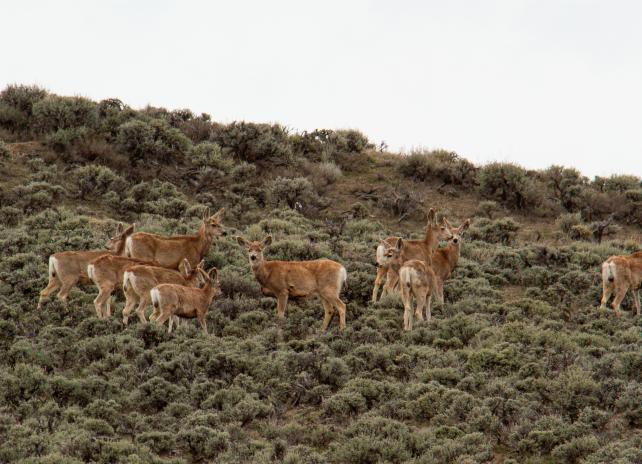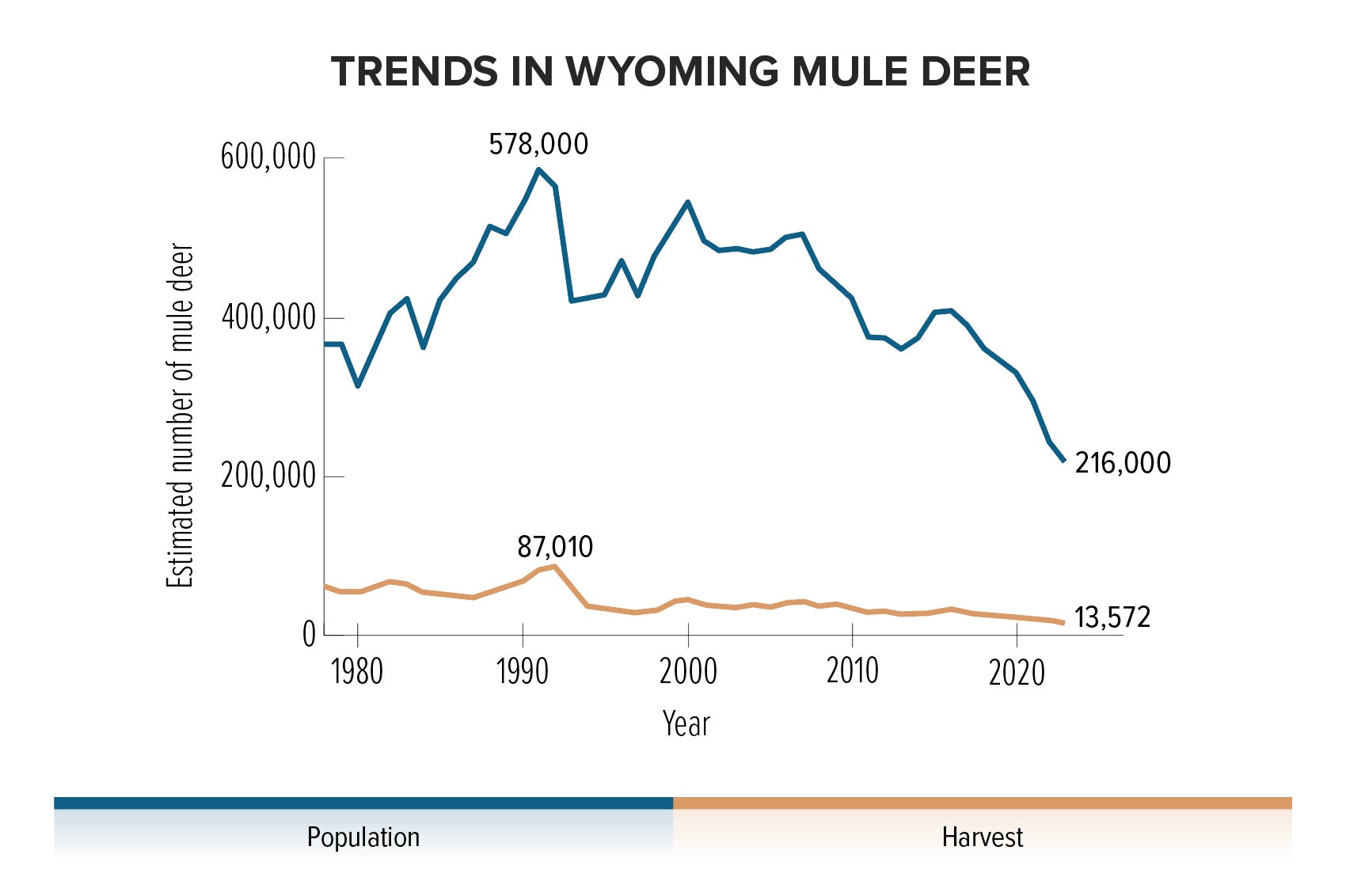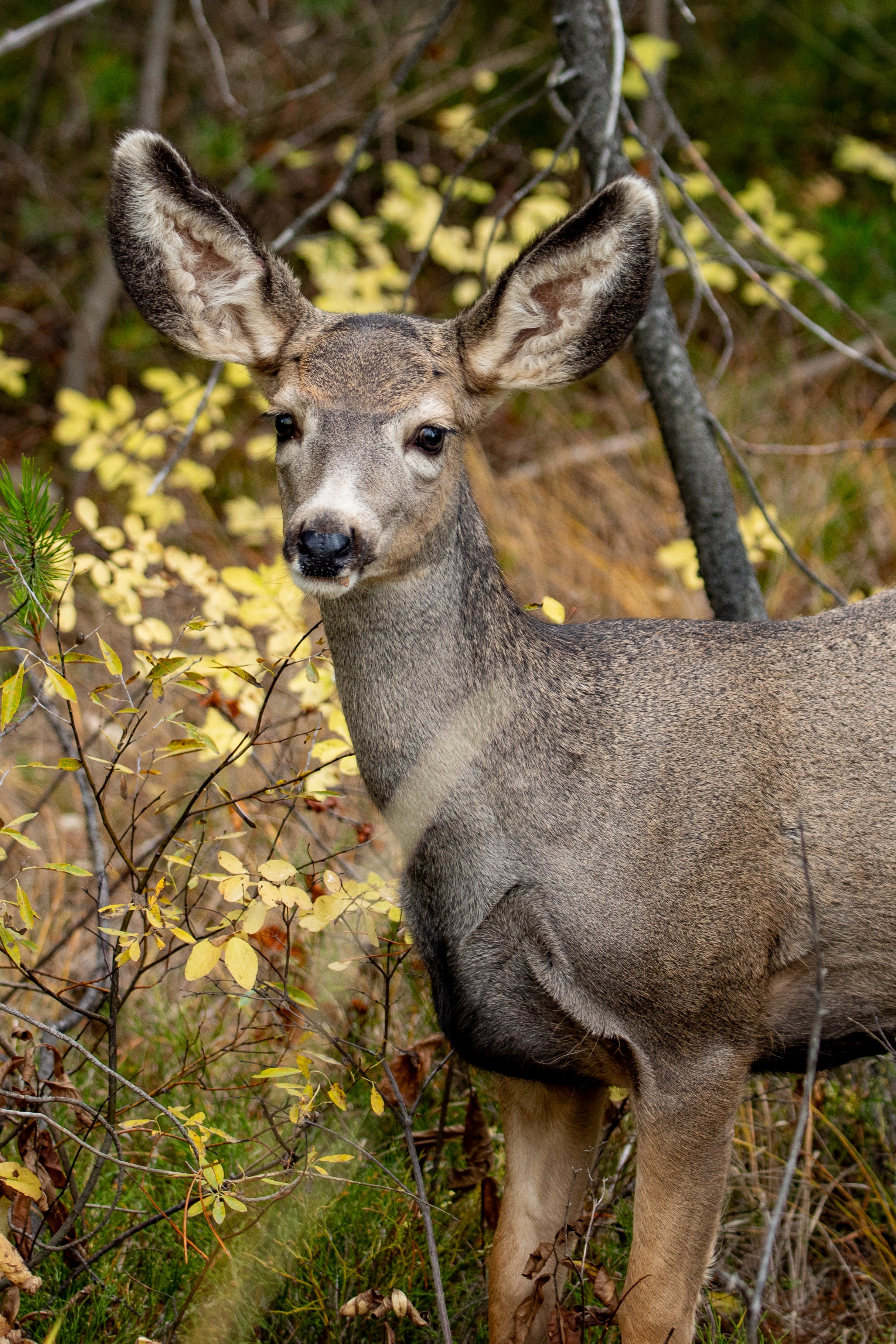
Mule Deer in Wyoming
Mule deer are an iconic species in Wyoming, drawing the interest of hunters and wildlife viewers alike. Mule deer populations have been in decline across the west for decades, and the Wyoming Game and Fish Department works continuously to better understand and conserve this species.
Visit the species profile to learn more about mule deer
The mule deer is an iconic American ungulate. Tap the link below to learn more about this species.
Mule deer community conversations
You can continue to stay involved in mule deer management in a variety of ways. View the public meeting analysis from the information we heard from the public during Mule Deer Conversation meetings across the state.
The Decline In Mule Deer
Wyoming’s mule deer are not only a cherished part of our wildlife heritage but also play a crucial role in our ecosystem and rural economies. Historically, mule deer were relatively uncommon in the early 1900s. Due to favorable conditions, populations surged in the 1950s and 1960s and reached historic highs. The most recent population peak occurred in 1991, with around 578,000 mule deer in the state. However, by 2023, this number has declined to an estimated 216,000 animals. Sharp declines in mule deer have occurred throughout western North America, most notably due to habitat loss and degradation along with changing weather patterns.
Mule deer declines highlight the continued need for action. Game and Fish, along with many partners, has long been dedicated to addressing these challenges through implementing large scale habitat projects, working to minimize impacts to habitat, highway crossing projects, research and conservative hunting seasons. It is critical we continue – and even expand – mule deer conservation efforts while ensuring Game and Fish understands current public sentiment toward managing hunting opportunities now and into the future.

The Work of Game and Fish
Research
Science, Research and Analytical Support Unit (SRA)
In 2021, Game and Fish established the SRA unit dedicated to improving survey and population estimation techniques, as well as tackling special research projects to support conservation and management efforts. One such effort is the Mule Deer Focal Herd Project, which is resulting in enhanced population monitoring in herds across the state.
Working with research partners Game and Fish has funded and collaborated on extensive research projects with the University of Wyoming. These research projects have focused on studying migration, body condition, disease, survival and predation. The research conducted will help inform future management decisions.
Management
Game and Fish works to provide hunting opportunities while ensuring biologically
appropriate levels of harvest. Seasons are reviewed annually to allow changes. When biologists set harvest numbers, they consider:
- • What is biologically appropriate for mule deer and their habitats.
- • Private property conflicts.
- • Hunter attitudes and recreational opportunities.
- • Management recommendations outlined in the Wyoming CWD Management Plan.
Wyoming’s mule deer hunting seasons have long been conservative, with buck-only harvest allowed in most of the state. Doe survival and fawn production drive population growth.
Hunter Attitude Survey
Hunter attitude surveys help Game and Fish understand the desires of hunters. In 2023, Game and Fish surveyed Wyoming resident hunters to better understand their perspectives on mule deer management and their opinions about current and future mule deer hunting opportunities. All Wyoming residents who held a mule deer license in the past three years received the survey; more than 77,000 people, with over 10,000 hunters responding. Game and Fish manages mule deer hunting opportunities based on what is biologically appropriate for populations while balancing public sentiment. Conservative buck-only hunting seasons do not affect the overall health of mule deer populations, although differences between season structures do affect hunter opportunity and hunting quality.
The Wyoming Mule Deer Initiative
The Wyoming Mule Deer Initiative (MDI) identifies the most pressing issues affecting mule deer, establishes goals and objectives for management, and recommends strategies for implementation. The strategies include a broad range of program-level actions. While much is yet to be done, we provide examples of management actions being implemented to address many of the issues. These examples are not all inclusive. The intent ultimately is to continue improving the effectiveness of our mule deer management program and to better engage and involve the public in developing management recommendations. The overarching goals and objectives set forth in this initiative are intended to provide guidance for developing individual herd unit management plans and strategies. These herd unit plans will identify specific issues, opportunities, and management actions on local and regional scales.
The MDI is intended to focus efforts and available resources by emphasizing the following strategies:
Conserve, enhance and restore mule deer habitat essential for population maintenance, reproduction and survival;
Through hunting frameworks, manage mule deer populations at sustainable levels that will maintain productive habitat conditions and provide recreation opportunity;
Apply the best available science, within budgetary constraints, to monitor mule deer populations and habitat condition;
Develop cooperative working relationships with universities and other institutions to conduct applied research needed to improve mule deer management;
Increase stakeholder awareness and involvement in the issues affecting conservation of mule deer, as well as opportunities to address those issues;
Enhance funding and public support for mule deer management; and
Collaborate with federal and state land management agencies to develop land use policies that will conserve and improve mule deer habitats.

Connecting mule deer to healthy habitats
Habitat improvements
Identifying and restoring crucial habitat remains a priority for the conservation of Wyoming’s mule deer.
Wildlife crossing work
In the last five years, Game and Fish, the WYldlife Fund, WYDOT and various partners have completed three significant wildlife crossing projects on major Wyoming highways.
Migration corridors
Game and Fish is a nationwide leader in the science of migration with a wealth of GPS collar data and the longest-documented mule deer migration in the world.
Additional resources
-
Answer
Carrying capacity – how many deer can we have?
Understanding mule deer and antler point restrictions
Illegal harvest and mule deer populations
Fertility control and mule deer population management
Mule deer management and the public process
Managing hunting for opportunity or mature bucks
Population management and objectives
Historical and current mule deer abundance
Arial inventory for mule deer management
Antler point restrictions
Understanding mule deer and antler point restrictions
A critical review of mule deer antler point regulations
Management strategy maps
Deer season opening dates 2024




